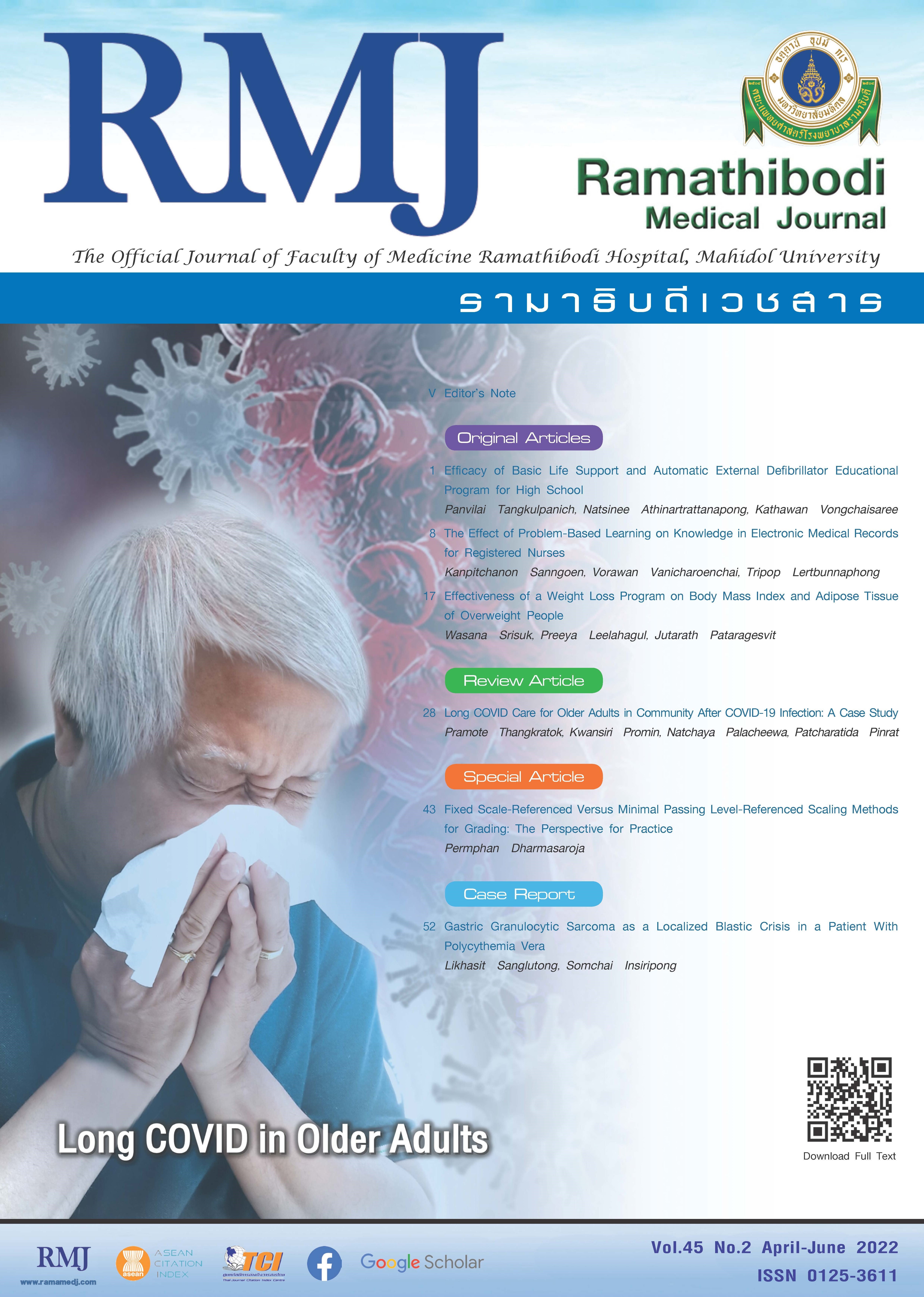Effectiveness of a Weight Loss Program on Body Mass Index and Adipose Tissue of Overweight People
DOI:
https://doi.org/10.33165/rmj.2022.45.2.249011Keywords:
Effectiveness, Weight loss, Personnel, ObesityAbstract
Background: Overweight and obesity have a negative impact on health. Adipose tissue is the most accurate indicator of obesity.
Objective: To study the effectiveness of a weight management program by comparing body weight and adipose tissue before and after joining the program.
Methods: A weight control program of the personnel of the Faculty of Medicine Ramathibodi Hospital, Mahidol University, was organized. It consisted of 1) individual counseling, 2) monthly healthy cooking group activities, 3) 3-day weekly exercise group activities, and 4) LINE group communication. The data were collected by a body composition measure and were analyzed, using descriptive statistics and paired t test statistics.
Results: A total of 78 participants had lower mean body weight after participating in the program than before participating in the program with significantly statistical implication (mean [SD], 64.8 [13.01] and 66.6 [13.09] kg, respectively; P < .05), and had lower mean adipose tissue than before participating in the program with significantly statistical implication (mean [SD], 34.6 [6.93] and 35.5 [6.97] % of body weight, respectively; P < .05).
Conclusions: The weight control program which focused on individuals and group activities as well as group communication was effective, enabling the participants to promote health behavior to better control weight.
References
Kanchanapiboonwong A, Kumwangsanga P, Keawta S. NCDs Situation Report: Diabetes, High Blood Pressure and Related Risk Factors in 2019. Division of Non Communicable Disease, Department of Disease Control, Ministry of Public Health. October 5, 2020. Accessed February 14, 2022. http://www.thaincd.com/2016/media-detail.php?id=13865&tid=&gid=1-015-005
Phunnasin B, Parnsila V, Butsaenkom R. Development of operation management to reduce for obeses people in community Nong Sang Sub-District, Wapi Prathum District, Mahasarakham Province. J Sci Tech UBU. 2017;19(2):108-123.
Maton T, Suphankul P. Effect of Thais without big belly project on reduce BMI and waist circumference of participants in project in area of Lower Norther Region. J Public Health. 2012;42(3):83-94.
Health Promoting Hospital, Regional Health Promotion Center 6. Results of the Clinic for Thai People Raipoong according to the standards of the Department of Health, Fiscal Year 2010. 2010;13-14. Accessed February 14, 2022. https://bit.ly/3IcJ6Zu
Thai Health Project. Thai Health 2019: Online Social Media – A Double Edged Sword 92 Thai health in the Context of a Socially-Connected World. Institute for Population and Social Research, Mahidol University; 2019. Accessed February 14, 2022. https://www.hiso.or.th/hiso5/report/report2019e.php
Bandura A. Self-Efficacy: The Exercise of Control. W. H. Freeman; 1997.
Bandura A, McClelland DC. Social Learning Theory. Prentice Hall; 1977.
Kuanra-ngub S. Behavior modification program for weight control of Payap University personnel. Nursing Journal. 2014;41(1):85-95.
Traisaeng A. Body Composition Assessment. Faculty of Liberal Arts, Maejo University. Accessed February 14, 2022. http://www.libarts.mju.ac.th/Lib_Ebook.php
Muangprom M. Norms of Percent Body Fat of Physical Education Teachers in Secondary School Region III. Master’s thesis. Physical Education, Faculty of Education, Prince of
Songkla University; 1998. Accessed February 14, 2022. https://kb.psu.ac.th/psukb/bitstream/2553/2744/2/142896.pdf
Phongsukrat P, Thaoboonyapinikul W, Chanta K. Result of program behavior change good health Wang’s way 90 days we can change. Journal Phrae Public Health for Development. 2017;7(6):59-67.
Downloads
Published
How to Cite
Issue
Section
License
Copyright (c) 2022 Ramathibodi Medical Journal

This work is licensed under a Creative Commons Attribution-NonCommercial-NoDerivatives 4.0 International License.

















